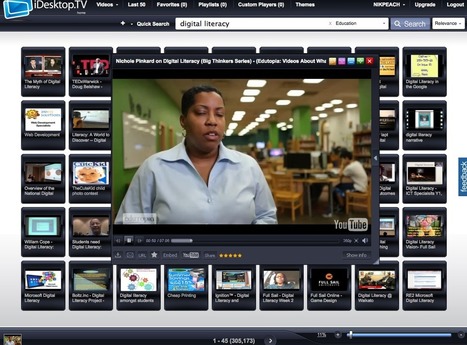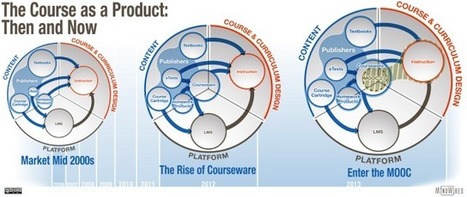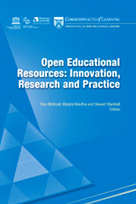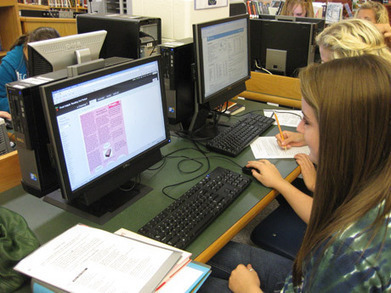 Your new post is loading...
 Your new post is loading...
"“Our students deserve a 21st century education.” I’ve heard this often during my career, and while I can sometimes name the 4 Cs, I’m concerned that educators are trying to adapt 20th century practices and experiences to the future we can’t even define yet. This phenomenon manifests itself typically by the rapid and ill-advised adoption of any and all technological products, i.e. hardware, software, personal devices, portable devices, and on and on and on. While it is true the technology and expertise necessary to manipulate this technology are important to 21st century skills, we, as educators, must not fall into the trap of imposing our cemented perspectives cured from our fleeting experiences of the past upon the students of the future. In this wave of Bring Your Own Device or Technology, depending on which variant you prefer, (BYOD), the instructional shift that must happen to fully capture the power of this movement is grossly behind the crest."
Via John Evans

|
Rescooped by
Dennis Swender
from Into the Driver's Seat
June 7, 2013 9:21 AM
|
By Bridget McCrea "Ready to bring collaboration into your classroom? Here are eight free apps and tools you can use to get students working -- and learning -- together, in and out of the classroom. (Note that while some of the app developments may charge for "premium" versions of these products, all of the following apps are free to use at a basic level)."
Via Jim Lerman
iDesktop.tv provides a really useful and user friendly service for anyone who wants to use video clips from sources like YouTube, but doesn't want their students looking around at anything unsuitable, or for anyone who has ever found a really useful clip, only to go back later and find it has moved or been removed.
Via Nik Peachey
Different from other presentation apps, 30hands Mobile focuses on the power of storytelling. Like pages in a book, photos or images are dragged around the desktop into the order of the story. Next, the teacher or student records audio over each image. Finally, the story or presentation can be published to the device’s photo area or uploaded to a 30hands collaborative learning site.
Via Baiba Svenca

|
Rescooped by
Dennis Swender
from Learning & Technology News
June 3, 2013 9:53 AM
|
Shared online videos have become quite popular. These streamed videos are so pervasive that 69% of Internet users and 52% of adults in the United States have watched or downloaded videos online (Purcell, 2010). It was predicted that videos would represent 50% of total data transfers on the Internet by 2012 (Madden, 2007). These statistics leave little doubt as to the rising importance of shared online videos for educational purposes.
Via Nik Peachey

|
Rescooped by
Dennis Swender
from Learning & Technology News
June 3, 2013 9:49 AM
|
So far I have come up with a number of 'first impression' criteria that I think I apply before even thinking about 'how' I will use the app / tool.
Via Nik Peachey

|
Rescooped by
Dennis Swender
from Learning & Technology News
June 3, 2013 9:47 AM
|
While much has been written about the use of learning technologies generally and about ePortfolios in particular, there has been a lack of robust evidence about their added value for enhancing student learning opportunities. A case study of the integration of ePortfolios into a professional development master’s program in a Higher Education Institution in Ireland is presented, and added value in terms of the creative learning process is explored.
Via Nik Peachey

|
Rescooped by
Dennis Swender
from Learning & Technology News
June 3, 2013 9:45 AM
|
Recently, I've been noticing that a lot of instructors are under the impression that they are successfully integrating technology, when in fact they are simply using technology. Although this might...
Via Nik Peachey

|
Rescooped by
Dennis Swender
from Learning & Technology News
June 3, 2013 9:38 AM
|
These arguments miss the point of the MOOC, and that point is, precisely, to make education available to people who cannot afford pay the cost to travel to and attend these small in-person events. Having one instructor for 20-50 people is expensive, and most of the world cannot afford that cost. That's *why* the institutions - from which the attendees of this conference were uniquely selected - charge thousands of dollars of tuition every year.
Via Vance Stevens, Nik Peachey

|
Rescooped by
Dennis Swender
from Learning & Technology News
June 3, 2013 9:32 AM
|
As teachers, when we assign a research project, we often focus on the end product: the research essay, presentation, etc. However, students (especially young students) do not automatically know how to conduct meaningful research. Our modern students are used to Googling answers. They have grown accustomed to information being readily available. However, as academics, we know that research isn’t a fast process. It’s slow and deliberate. As a teacher, I need to intentionally slow my students down during this exercise. I do this by breaking down a larger project into more manageable chunks and focusing on the process.
Via Nik Peachey

|
Rescooped by
Dennis Swender
from Learning & Technology News
June 3, 2013 9:31 AM
|
In 2010, the UNESCO Institute for Information Technologies in Education (UNESCO IITE) and the European Agency for Development in Special Needs Education agreed to collaborate on a joint project to develop a Review of Innovative Practice – a report presenting concrete examples of practice of the use of Information and Communication Technology (ICT) with people with disabilities in different educational contexts and settings. In particular, the Review was targeted at considering examples of practice that can be considered to be ‘innovative’ within the specific educational setting and wider societal context they were situated within.
Via Nik Peachey

|
Scooped by
Dennis Swender
June 3, 2013 12:30 AM
|
Does your learners prefer acquiring and processing information via images, pictures, maps, graphs, charts, illustrations, and other visual aids? Since they are visual learners have you though of using infographics at your course?
It’s time to share your presentation! Whether you’re delivering a business proposal to a client, an academic presentation to your professor, or even showing a personal photo slide to your grandmother, you have to ensure that your visuals can be clearly seen by your audience.
Via Baiba Svenca
|

|
Rescooped by
Dennis Swender
from Colorful Prism Of Racism
June 7, 2013 9:22 AM
|
After the terribly tragic events that took place in Boston, the country has pulled together to mourn our losses and move on. The new immigration bill is still in process of being reviewed and debated on Capitol Hill, but one thing that hasn’t really been discussed is the state of undocumented women, particularly victims of sexual abuse and rape. Regardless of where you stand on the issue of immigration, the truth is that the sooner rape victims receive help; the better they are at handling trauma. The Violence Against Women Act signed by President Obama earlier this year covers undocumented women who are victims of domestic violence. What does this mean for the new immigration bill?
Via Deanna Dahlsad

|
Rescooped by
Dennis Swender
from Content Curation World
June 7, 2013 9:21 AM
|
Curation tools and web services designed to create learning paths, curriculums, thematic collections and PKM portfolios
Via Robin Good

|
Scooped by
Dennis Swender
June 7, 2013 9:16 AM
|
Abstract (pasted from AERA 2013 program) This study investigated relationships between how students “listen” (access existing posts) and “speak” (contribute posts) in asynchronous online discussions. Eleven variables indexing four dimensions of student’s listening (breadth, depth, temporal contiguity and revisitation) and five variables indexing three dimensions of students’ speaking (discursiveness, depth of content, and reflectivity) were calculated for 31 students participating in six week-long online discussions as part of an undergraduate educational psychology course. Multiple regression analysis indicated that the breadth of students’ listening (the percentage of peers’ posts viewed) predicted both the responsiveness and argumentative quality of their posts, but the depth with which they attended to the posts (time spent viewing) did not. Implications for the theory and practice of online discussions are discussed.

|
Rescooped by
Dennis Swender
from Learning & Technology News
June 3, 2013 9:53 AM
|
Once an advocate for using social media applications and cell phones in class, this English teacher has changed his stance on the kinds of technology teachers should incorporate into their instruction.
Via Nik Peachey

|
Rescooped by
Dennis Swender
from Learning & Technology News
June 3, 2013 9:50 AM
|
As our classroom shifted from teacher- to student-centered, my students began to do the majority of their own research. Sometimes, this means they teach each other. Sometimes, they create a project around the knowledge they are acquiring. Sometimes, they create their own driving questions. Sometimes, they create their own units.
Via Nik Peachey

|
Rescooped by
Dennis Swender
from Learning & Technology News
June 3, 2013 9:49 AM
|
Networking is a key skill in professional careers, supporting the individual’s growth and learning. However, little is known about how professionals intentionally manage the connections in their personal networks and which factors influence their decisions in connecting with others for the purpose of learning. In this article, we present a model of personal professional networking for creating a personal learning network, based on an investigation through a literature study, semi–structured interviews and a survey.
Via Nik Peachey

|
Rescooped by
Dennis Swender
from Learning & Technology News
June 3, 2013 9:46 AM
|
The fact that we now look to the Silicon Valley to “democratize” education indicates how successful that project has been: even those who care about public goods like universal access to education are willing to let the world of hi-tech entrepreneurship take up the burden.
Via Nik Peachey

|
Rescooped by
Dennis Swender
from Learning & Technology News
June 3, 2013 9:39 AM
|
First and foremost, student writing is improving by leaps and bounds. When I read their blogs (which, by the way, are mature, insightful, funny and engaging), I don't find myself pulling my hair out over the careless mistakes they make in formal papers. Not every post is perfect, but the majority are well written and free of grammar and usage issues that I am so familiar with seeing in their other work. If they become sloppy, all I need to do is politely comment about it on their blog, and I don't see it again.
Via Nik Peachey

|
Rescooped by
Dennis Swender
from Learning & Technology News
June 3, 2013 9:34 AM
|
I developed this quiz with members of my personal learning network (found at end of post) to get students thinking about their digital footprint. The quiz was created at the request of high school students I spoke with who thought the creation of a such a quiz could lead to a smart conversation about ways students can update their digital footprint so that it is one that leads to college and career success.
Via Nik Peachey

|
Rescooped by
Dennis Swender
from Learning & Technology News
June 3, 2013 9:32 AM
|
This book, initiated by the UNESCO/COL Chair in OER, is one in a series of publications by the Commonwealth of Learning (COL) examining OER. It describes the movement in detail, providing readers with insight into OER’s significant benefits, its theory and practice, and its achievements and challenges. The 16 chapters, written by some of the leading international experts on the subject, are organised into four parts by theme
Via Nik Peachey

|
Rescooped by
Dennis Swender
from Learning & Technology News
June 3, 2013 9:25 AM
|
The technology they use in their personal lives just makes sense for use in their learning as well. If a student badly wanted a new tablet or app for his or her own personal use but wanted nothing to do with it for any kind of learning whatsoever, we may need to look at the disconnect. But there are other reasons why education consistently turns to technology
Via Nik Peachey

|
Rescooped by
Dennis Swender
from Learning & Technology News
June 2, 2013 3:49 AM
|
With more and more schools going paperless or migrating to the "cloud" (storing files on the Internet), student work has become more easily shareable, accessible by many, and more easily organized. Many teachers have turned to digital portfolios -- or "e-portfolios" -- for their students. These digital portfolios have caused a huge shift in how teachers assign, collect and assess student classwork and projects.
Via Nik Peachey
|



 Your new post is loading...
Your new post is loading...

![We have a BYOD program, but now what? [guest post] | Dangerously Irrelevant | Distance Learning, mLearning, Digital Education, Technology | Scoop.it](https://img.scoop.it/-iMT7d6JZF7s74M16Sz1aDl72eJkfbmt4t8yenImKBVvK0kTmF0xjctABnaLJIm9)









































































BYOD!!!!